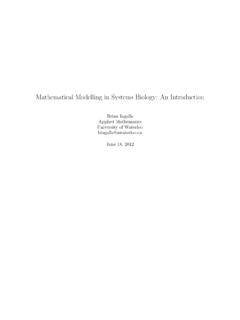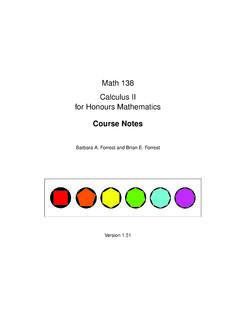Transcription of Lecture 1s Finding the Line of Intersection of Two Planes ...
1 Lecture 1sFinding the Line of Intersection of Two Planes (page 55)Now suppose we were looking at two planesP1andP2, with normal vectors~n1and~n2. We saw earlier that two Planes were parallel (or the same) if andonly if their normal vectors were scalar multiples of each other. But what iftwo Planes are not parallel? Then they intersect, but instead of intersecting ata single point, the set of points where they intersect form a line. Let s call thelineL, and let s say thatLhas direction vector~d. Then sinceLis contained inP1, we know that~n1must be orthogonal to~d.
2 And, similarly,Lis contained inP2, so~n2must be orthogonal to~das well. That means that to find~d, we needto find a vector that is orthogonal to both~n1and~n2. Luckily we know how todo that :Find a vector equation of the line of intersections of the two planesx1 5x2+ 3x3= 11 and 3x1+ 2x2 2x3= we read off the normal vectors of the Planes : the normal vector~n1ofx1 5x2+ 3x3= 11 is 1 53 , and the normal vector~n2of 3x1+ 2x2 2x3= 7 is 32 2 .Next, we find the direction vector~dfor the line of Intersection , by computing~d=~n1 ~n2= 1 53 32 2 = ( 5)( 2) (3)(2)(3)( 3) (1)( 2)(1)(2) ( 5)( 3) = 4 7 13.
3 Now, those steps were all straightforward. But there is still something veryimportant missing a point on the line! That is, we need to find a pointPthatis on both Planes . A quick trick to narrow down the possibilities is to set thevalue of one of the variables. So I ll choose to fixx3= 0, and then I am lookingfor a point satisfying bothx1 5x2+ 0 = 11 and 3x1+ 2x2+ 0 = 7. Butx1 5x2+ 0 = 11 means thatx1= 11 + 5x2. Plugging this fact into the secondequation gives us 3(11 + 5x2) + 2x2= 7 x2= 2. And sox1= 1,and we see thatP(1, 2,0) is a point on both Planes .
4 (We can plugPin tothe given equations of the plane to double check: (1) 5( 2) + 3(0) = 11 and 3(1) + 2( 2) 2(0) = 7.)So, we have a point (1, 2,0) on the line, and a direction vector 4 7 13 forthe line, so a vector equation of the line is1 1 20 +t 4 7 13 , t RWant to double check this? Settingt= 1, we get the pointQ(5, 9,13) on theline. We can plugQinto the given equations of the Planes to verify thatQisalso on both









